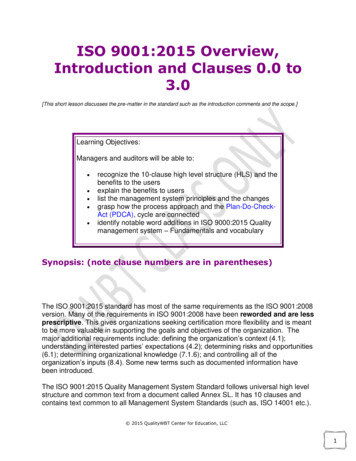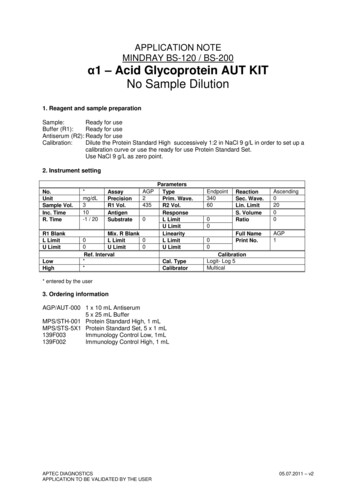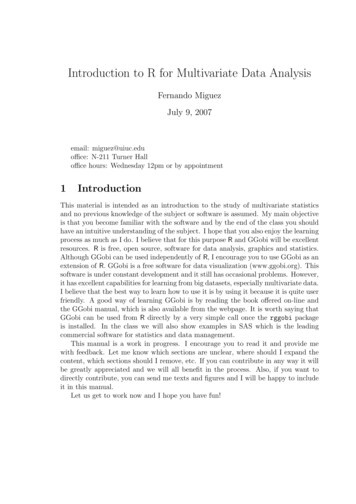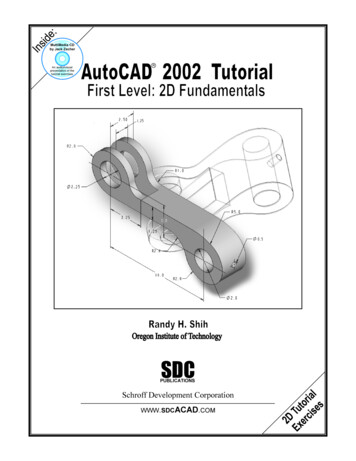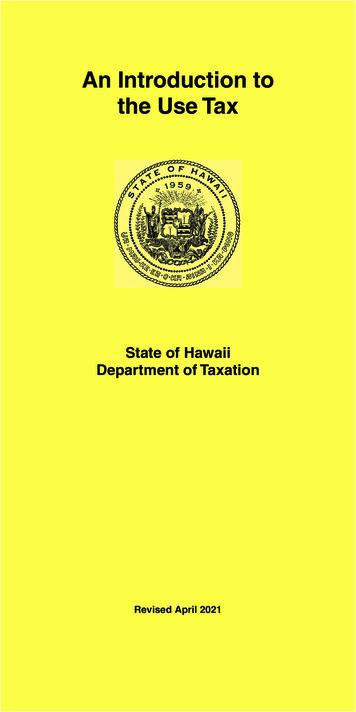
Transcription
1IntroductionHow to use this manualThis manual is divided into seven chapters and is intended for researchers interested inusing our EF battery, as well as for assessors who will be administering it. The individualchapters can be used as stand-alone documents. However, for a complete understanding of theEF battery we advise reading the entire manual. Within this manual you will find a detaileddescription of the individual tasks and how they were developed through our extensive pilotwork and testing. The manual also provides a detailed description of the psychometric propertiesof the battery and how this provides insight into how the battery should be administered. Finally,in this manual, you will find comprehensive information on how to administer the battery andinterpret the scores.Chapters one, two and three will be most useful for researchers and students interested ina comprehensive overview of how the individual tasks were selected, modified, and conceived ofas a single indicator of EF. Chapter two specifically provides information on the psychometricproperties of the battery and how it was validated using a large representative sample. Thischapter may also be informative to those who are interested in the quantitative work that hasbeen conducted with the battery. Chapter three explains the process of transitioning into acomputerized assessment and provides some information on the psychometric properties of thebattery in this format.Chapters four, five and six will be most useful for assessors, who will be administeringthe battery. Chapter four provides the most detailed information on the individual tasks and howthey are administered. This chapter was written to promote assessor comprehension and to
2answer questions that commonly occur during administration. Chapter four will also beimportant for researchers who are planning on selecting certain tasks, from the complete battery,based upon content interests or time restrictions. Chapter five provides specific details and tipsfor administering the battery. This chapter only provides brief descriptions of the individualtasks, for more detailed descriptions please read chapter four. Chapter six provides a technicaloverview of how to set up the equipment and should be read by all assessors beforeadministering the battery.Chapter seven will be utilized be anyone responsible for managing data or conductinganalyses with data from the EF Touch battery. This chapter defines variable names and containsrecommendations on how to use specific variables for scoring proposes.
3Chapter OneHistory of Executive Function Tasks and Task OverviewExecutive function (EF) is an “umbrella term” that refers to a wide range of cognitiveabilities involved in the control and coordination of information in the service of goal-directedactions (Fuster, 1997; Miller & Cohen, 2001). As such, EF can be defined as a supervisorysystem that is important for planning, reasoning ability, and the integration of thought and action(Shallice & Burgess, 1996). At a more fine grained level, however, EF, as studied in thecognitive development literature, has come to refer to specific interrelated informationprocessing abilities that enable the resolution of conflicting information; namely, workingmemory, defined as the holding in mind and updating of information while performing someoperation on it; inhibitory control, defined as the inhibition of prepotent or automatizedresponding when engaged in task completion; and mental flexibility, defined as the ability toshift attentional focus or what is referred to as cognitive set among distinct but relateddimensions or aspects of a given task (Garon, Bryson, & Smith, 2008; Zelazo & Müeller, 2002).Here we summarize our ongoing efforts to develop and rigorously evaluate a battery ofexecutive function tasks for use across the early childhood period (i.e., 3-5 years of age). Whenwe began working in this area approximately 7 years ago, there were relatively few task batteriesavailable that represented the tripartite organization of EF (inhibitory control [IC], workingmemory [WM], attention shifting [AS]), that had undergone rigorous psychometricevaluations—including use with children from disadvantaged settings that yielded scalablescores to facilitate estimates of within person changes in ability, and that were amenable for useby lay interviewers (without expertise in EF) in large scale, field-based settings.
4Under the auspices of NICHD funding (R01 HD51502), we sought to develop a testbattery that addressed these limitations. Specifically, we were interested in developing tasks thatrepresented a broad range of ability level and that yielded individual differences in EF abilitylevels between 3-5 years of age. Moreover, we wanted tasks that were highly portable, thatpresented tasks in a uniform format, and that included highly scripted instructions, making themamenable for use by lay data collectors who had limited experience in standardized testing andno content knowledge of EF. In addition, we constructed tasks such that one person administeredthe tasks while a second person recorded child responses, in order to reduce the cognitivedemand for data collectors and improve data quality. Finally, we were interested in tasks thatwere both appropriate for young children and that were ostensibly designed to measure thedistinct components of EF (understanding that there are no completely “pure” measures of WM,IC, or AS) that have been critical for testing fundamental questions about the organization of EFin early childhood.Our work proceeded in three stages. The first stage involved an iterative process of taskdevelopment and pilot testing and concluded by administering the first complete task battery in across sectional sample of children between the ages of 3 and 5 years. The second stage involvedintroducing the task battery into a population-based longitudinal sample of 1,292 children andfamilies followed from birth (i.e., the Family Life Project; P01 HD39667). The third stageinvolved a new round of task revisions that were intended to facilitate the migration of thebattery from a flip book to computer-based administration format.Initial Task Development
5We initially set out to identify extant tasks that had been used with preschool age childrenthat putatively measured three aspects of EF—inhibitory control (IC), working memory (WM),and attention shifting (AS)—and that could be adapted for use with very young children whoresided in low income households. The focus on young and disadvantaged children was tofacilitate our second stage of psychometric work, which involved direct assessments of EF in 3year old children who were part of the Family Life Project, a NICHD-funded population basedcohort that over-sampled low income and, in NC, African American families.The initial set of tasks was developed as a series of “card games” that were intended toprovide a uniform testing format. Nine potential tasks were trimmed to six following ourexperiences with pilot testing (some tasks were difficult for the youngest children to understand).Pilot testing also revealed that a “card game” format was not ideal, as cards required sorting aftereach administration and the likelihood of sorting-related errors was large. We subsequentlymigrated the tasks into a series of bound “flip books,” which eliminated sorting problems andfacilitated the scripting of instructions for administrators (the opened flip book sat between theexperimenter and the child; one page presented a stimuli to the child while the other pageprovided scripted instructions that were read to the child by the experimenter or that otherwiseprompted the experimenter as to what to do). We worked with a commercial artist to developprofessional looking stimuli, a graphic designer and printer to construct bound flip books, and acomputer programmer who developed software to record child responses into laptops.Using the flip book format, we engaged in an extended period of iterative pilot testingand task modification with a total of 120 children. During this period, no formal data werecollected. Rather, two data collector teams independently tested children to gain impressions ofhow tasks worked and what modifications might be useful. Conference calls involving data
6collectors and investigators led to recommended changes, implemented by a graphic designerand subsequently pilot tested again. Major emphases were developing language that describedtask objectives in ways that were understandable to young children and structuring tasks in waysthat made minimal language demands on children in order to respond. A synopsis of the final setof tasks retained from this initial task development period follows.Task DescriptionsTwo tasks were developed that putatively measured working memory. The WorkingMemory Span (Houses) task was based upon principles described by Engle, Kane andcollaborators (e.g., Kane & Engle, 2003) in which the object is to hold multiple representationsin mind simultaneously and to selectively respond to only one. In this task, children arepresented with a line drawing of an animal with a colored dot above it, both located within theoutline of a house. The examiner asks the child to name the animal and then to name the color ofthe dot. The examiner then turns to a page which only shows the outline of the house from theprevious page, and asks the child which animal was/lived in the house. The task requires childrento perform the operation of naming and holding in mind two pieces of informationsimultaneously and to activate the animal name while overcoming interference occurring fromhaving named the color. The number of houses on each page scales difficulty level. The Pick thePicture (PtP) task is a self-ordered pointing task (Cragg & Nation, 2007; Petrides & Milner,1982). Children are presented with a set of identical pictures that appear on a series ofconsecutive pages. On each page, they are instructed to pick a new picture that had not beenpreviously selected so that all of the pictures “get a turn.” The arrangement of pictures withineach set is randomly changed across trials so that spatial location is not informative. The numberof pictures contained in each set scales difficulty level.
7Three tasks were developed that putatively measured inhibitory control. The Silly SoundsStroop (SSG) task was derived from the Day-Night task developed by Gerstadt, Hong, andDiamond (1994). While showing the children pictures of a cat and dog, the experimenterintroduces the idea that, in the Silly Sounds game, dogs make the sounds of cats and vice versa.Children are then presented with pictures of dogs and cats and asked what sound a particularanimal makes in the Silly Sounds game (i.e., children are to ‘bark’ for each cat picture and‘meow’ for each dog picture). The second task that putatively measured inhibitory control is theAnimal Go/No-Go (Pig) task. This is a standard go no-go task (e.g., Durston et al., 2002)presented in a flipbook format. Children are presented with a large button that makes a clickingnoise when depressed. Children are instructed to click their button every time that they see ananimal on the flip book page unless that animal is a pig. Each page depicts one of seven possibleanimals. The task presented varying numbers of go trials prior to each no-go trial. The third taskthat putatively measured inhibitory control is the Spatial Conflict (SC) task. The SC is a simontask inspired by the work of Gerardi-Caulton (2000). Children receive a response card with apicture of a car on the left side and picture of a boat on the right side. The flip book pages depicteither a car or boats. The child is instructed to touch the car on his/her response card when theflip book page shows a car and to touch the boat on the response card when the page shows aboat. Initially, cars and boats are depicted in the center of the flip book page (to teach the task).Across a series of trials, cars and boats are depicted laterally, with cars (boats) always appearingon the left (right) side of the flip book page (“above” the car [boat] on the response card).Eventually test items begin to appear in which cars and boats are depicted contra-laterally(spatial location is no longer informative). In subsequent work, it was determined that the SCtask was too easy for 4 and 5 years-olds. Hence, a variation of the task, called the Spatial
8Conflict Arrows (Arrows) task was developed. It was identical in structure to SC with theexception that the stimuli were arrows and the response card showed two “buttons” (blackcircles). Children were to touch the left (right) button when the arrow on the flip book pagedpointed to the left (right) side of the page. Similar to SC, initially all left (right) pointing arrowsappeared above the left (right) button; however, during test trials left (right) pointing arrowsappeared above right (left) button.One task was developed that putatively measured attention shifting. The Something’s theSame (STS) task was a simplified version of Jacques and Zelazo’s (2001) flexible item selectiontask. In our variation, children are shown a page containing two pictures that are similar alongone dimension (content, color, or size). The experimenter explicitly states the dimension ofsimilarity. The next page presents the same two pictures, plus a new third picture. The thirdpicture is similar to one of the first two pictures along a dimension that is different from that ofthe similarity of the first two pictures (e.g., if the first two pictures were similar in shape, thethird card would be similar to one of the first two along the dimension of color or size). Childrenare asked to choose one of the two original pictures that is the same as the new picture.
9Chapter TwoFactor Structure, Measurement Invariance, Criterion Validity & Age Differences EFAfter the previously described iterative pilot testing, data were collected from aconvenience sample (N 229 children) in NC and PA. Children ranged from 3.0 to 5.8 years ofage and were recruited to ensure adequate cross-age variation. This sample was used to conductconfirmatory factor analyses (CFA) with the EF battery. A primary analytic objective ofdeveloping this battery was to test its dimensionality, to test whether it exhibited equivalentmeasurement properties for distinct subsets of youth, to examine the criterion validity, and toevaluate whether performance exhibited the expected improvements as a function ofchronological age.First, our EF tasks were best represented by a single latent factor, χ2(9) 4.0, p .91, CFI 1.0, RMSEA 0.00. With one exception, the EF latent variable explained approximately onethird of the variance of each task (Spatial Conflict: R2 .07; Go No-Go (Pig): R2 .29; WorkingMemory Span (Houses): R2 .34; Silly Sounds Stroop (SSG): R2 .40; Item Selection (STS): R2 .41; Self Ordered Pointing (PTP): R2 .47). Nearly two-thirds of the observed variation ineach task was a combination of measurement error and systematic variation unique to that task.This provided evidence in favor of pooling information across tasks in order to establish areliable index of latent EF ability. Moreover, the excellent fit of the 1-factor model arguedagainst the relevance of the tripartite organization of EF in early childhood.Second, a series of multiple groups CFA models were estimated in order to test themeasurement invariance of the 1-factor model separately by child sex (male vs. female) and agegroup (3-3.99 vs. 4-5 years), parental education (less than vs. 4 year degree), and household
10income (median split of 50,000/household). That is, we tested whether tasks were equally goodindicators of the construct of EF across subgroups of children. At least partial measurementinvariance was established for all comparisons (i.e., at least a subset of the tasks could take onequivalent measurement properties across all subgroups of children). This provided evidence thatthe task battery “worked”, in a psychometric sense, equivalently for a wide range of children.Measurement invariance facilitated our ability to make meaningful cross-group comparisons.Comparisons of latent means indicated that girls outperformed boys (Cohen d .75), olderchildren outperformed younger children (Cohen d 1.3), children whose parents had abachelor’s degree or higher outperformed children whose parents did not (Cohen d .54), andchildren from higher income households outperformed children from lower income households(Cohen d 0.44) on the EF battery (all ps .01).Third, in the total sample, the EF latent variable was negatively correlated with a latentvariable of parent-reported attention deficit hyperactivity disorder (ADHD) symptomatology (φ -.45, p .0001) and positively correlated with a direct screening assessment (i.e., WPPSIsubtests) of children’s IQ (φ .77, p .0001). These results were in the expected direction andprovided initial evidence supporting the criterion validity of the battery. Fourth, EF factor scoreswere positively correlated with chronological age (r .55, p .0001) and exhibited linearchange from age 3-6 years. An inspection of box and whisker plots of EF factor scores plotted byage group demonstrated that although children’s performance on the EF battery showed theexpected linear changes with increasing age, there were substantial individual differences inability level within any given age (see Figure 1). The ability of the EF task battery to preserveindividual differences within age group makes it an ideal measure for measuring longitudinalchange.
11In sum, at the conclusion of the first stage of our measurement development work, wehad developed a set of tasks that had undergone extensive pilot testing and revision, which werepresented in a uniform and easily portable format, and which could be easily administered bydata collectors with no expertise in EF. Analyses indicated that children’s performance on sixtasks was optimally represented by a single latent factor and that EF tasks worked in anequivalent way for children of different sexes, ages, and family backgrounds. Group differencesin latent EF ability were evident for females vs. males, older vs. younger children, and childrenfrom more (parental education, household income) vs. less advantaged homes. Criterion validitywas established by demonstrating that children’s performance on the battery correlated withparent-reported ADHD behaviors and their performance on two screening indicators of IQ.Finally, although there was evidence of developmental improvements in performance on thebattery, individual differences in ability were evident for children of the same age(s).Psychometric Properties of the EF Battery in a Large Scale EvaluationWith the successful completion of measure development activities in the pilot testing, theEF task battery was administered at the age 3, 4, and 5-year assessments of the Family LifeProject (FLP). The FLP is a NICHD-funded program project that was designed to study youngchildren and their families who lived in two of the four major geographical areas of the UnitedStates with high poverty rates. Specifically, three counties in Eastern North Carolina and threecounties in Central Pennsylvania were selected to be indicative of the Black South andAppalachia, respectively. The FLP adopted a developmental epidemiological design in whichsampling procedures were employed to recruit a representative sample of 1,292 children whosefamilies resided in one of the six counties at the time of the child’s birth. Low-income familiesin both states and African American families in NC were over-sampled (African American
12families were not over-sampled in PA because the target communities were at least 95% nonAfrican American). Interested readers are referred to a monograph-length description of studyrecruitment strategies and detailed descriptions of participating families and their communities(Vernon-Feagans, Cox, and the Family Life Project Key Investigators, 2011). Here, wesummarize the knowledge that was gained, specifically as it related to our EF task developmentefforts, from embedding the EF battery in the FLP study.The inclusion of the EF task battery at the age 3 year assessment of the FLP sampleprovided the first sufficiently large sample to begin evaluating the psychometric properties ofeach task individually, as well as their contribution to the overall battery. Three key resultsemerged from this study (see Willoughby, Blair, Wirth, Greenberg, & Investigators, 2010). First,91% of children who participated in the age 3-year home visit successfully completed one ormore EF tasks (median 4 of 5 tasks; note that the PTP task was not administered at the age 3assessment). Compared to children who completed one or more EF tasks, children who wereunable to complete any tasks were more likely to be male (77% vs. 47%, p .0001), to have aprimary caregiver who was unmarried (57% vs. 42%, p .005), and to differ on their estimatedfull scale IQ score using two subtests from the WPPSI (M 75.9 vs. M 95.1, p .0001). TheWPPSI scores, in particular, indicate that children who were unable to complete any EF taskswere developmentally delayed. Second, a CFA indicated that a 1-factor model fit the task scoreswell (χ2(5) 3.5, p .62, CFI 1.0, RMSEA 0.00). Although a 2-factor model fit the taskscores well too (χ2(4) 2.4, p .66, CFI 1.0, RMSEA 0.00), the 2-factor model did notprovide a statistically significant improvement in model fit relative to the 1-factor model, (χ2(1) 1.1, p .30). Hence, consistent with other relevant studies and the results from data collected inpilot testing, EF abilities were again best conceptualized as unidimensional (undifferentiated) in
13preschoolers. Third, a final set of CFA models were estimated to establish the criterion validityof the EF task battery. One latent variable represented children’s performance on the EF taskbattery (each task was an indicator of underlying EF ability). The other two latent variablesrepresented criterion measures: multiple informant (parent, day care provider, research assistant)ratings of ADHD behaviors and estimated intellectual functioning (based on performance onBlock Design and Receptive Vocabulary subtests of the WPPSI). This 3-factor model fit theobserved data well (χ2(32) 36.0, p .29, CFI 1.0, RMSEA 0.01). The EF latent variable wasstrongly negatively correlated with ADHD (φ -.71, p .001) and strongly positively correlatedwith IQ (φ .94, p .001). These results replicated those obtained in Stage 1. Although thecorrelation between EF and IQ approached unity, it was in line with the range of effects thatwere observed in the adult literature (Kane, Hambrick, & Conway, 2005).In addition to replicating tests regarding the dimensionality and criterion validity of theEF battery, the large sample size of the FLP provided the first opportunity to evaluate thepsychometric properties of individual tasks. We relied extensively on Item Response Theory(IRT) methods for psychometric evaluation of individual EF tasks. IRT methods had threeadvantages that were directly relevant to our work. First, IRT methods provide a principledapproach for testing differential item functioning (DIF). DIF is a formal approach for evaluatingwhether individual items on each EF task work equally well for subgroups of participants. Rulingout DIF ensured that any observed group differences in ability were not an artifact of differentialmeasurement operations. Second, IRT methods provided an explicit strategy for generating taskscores that took into account the fact that test items varied with respect to their difficulty leveland discrimination properties. Failing to take into account differences in how each item behavesresults in under- or over-weighting particular items. Incorrectly weighting items can lead to scale
14scores that are biased and thereby less accurate when comparing individuals (or groups) withinor across time (Edwards & Wirth, 2009; Wirth & Edwards, 2007). A third advantage of IRTmethods was the ability to compute test information curves, which characterize variations in theprecision of measurement of each task as a function of a child’s true ability level. Testinformation curves consistently indicated that all of the tasks in our battery did a relatively betterjob of measuring lower than higher levels of true EF ability. These results informed subsequentefforts at task revisions (see below). We used data from the age 4-year assessment to provide anextended introduction to the merits of IRT methods for purposes of task evaluation (Willoughby,Wirth, & Blair, 2011).A test-retest study was embedded in the FLP age 4-year assessment (Willoughby & Blair,2011). Over a 6-week period, every family who completed a home visit (n 145) was invited tocomplete a follow-up (retest) visit 2-4 weeks later. The follow-up visit consisted of the readministration of EF tasks by the same research assistant who administered them at the first visit.Of the 145 families who were invited to participate, 141 accepted (97%). The mean (median)number of days that passed between the initial and retest visits was 18 (16) days, with a range of12-42 days. One child whose family agreed to participate in the retest visit was unable tocomplete any tasks, yielding 140 retest observations. Retest correlations of individual task scoreswere moderate (mean r .60; range .52 - .66). Although similar in magnitude to thoseobserved in other retest studies of EF in preschool, school-aged, and adult samples, we werediscouraged by these low values given the short retest interval (i.e., only 1/3 of the observedvariation in performance on any given EF task was shared across a two-week period). However,in contrast to individual tasks, confirmatory factor analyses demonstrated very high retestreliability (φ .95) of the task battery. This pattern of results was identical to those of an earlier
15study that demonstrated this approach with older adults (Ettenhofer, Hambrick, & Abeles, 2006).We concluded that children’s performance on any individual task consisted of a combination ofmeasurement error, systematic variance that was task specific and systematic variance thatrepresented general EF ability. Through the administration of multiple tasks, we were able toextract that variation that was common across EF tasks. The large retest correlations betweenlatent variables demonstrated a high degree of stability of the variation in ability that was sharedacross tasks. Perhaps more than any other manuscript that we published, this study underscoredthe critical importance of administering multiple tasks and defining EF ability using latentvariable models that were defined by that variation that was common (shared) across tasks.The inclusion of the EF task battery at the FLP age 5-year assessment yielded three majorfindings (Willoughby, Blair, Wirth, Greenberg, & Investigators, 2012). First, 99% (N 1,036)of the children who participated in this visit were able to complete one or more of the tasks(median 6 of 6). This represented an 8% increase in the completion rate from the 3-yearassessment. As before, those children unable to complete any tasks tended to exhibit a variety ofphysical and developmental delays that prohibited their participation in any direct child testing.Given the inclusive nature of the FLP sampling scheme (over-sample low income families, noexclusionary criteria except intention to move and speaking English as a primary language), the99% completion rate provided direct support for the use of this battery with children fromdiverse backgrounds. Second, also consistent with results from the age 3-year assessment,children’s performance on EF tasks continued to be optimally characterized by a single factor,χ2(9) 6.3, p .71, CFI 1.0, RMSEA 0.00. This indicated that the differentiation of EFability into more fine grained dimensions likely occurs after the start of formal schooling (seeShin et al., in press, for supporting evidence). Third, a series of CFA models, based on N 1,058
16children who participated in either the age 5 year and/or pre-kindergarten (i.e., a visit thatoccurred prior to the start of kindergarten) visits, were used to test whether children’sperformance on the EF battery was significantly related to performance on achievement tests. A2-factor model (one each for EF and academic achievement) fit the data well, χ2(43) 135.1, p .0001, CFI .96, RMSEA 0.05. The latent variables representing EF and academicachievement were strongly and positively correlated (φ .70, p .001). Moreover, follow upanalyses indicated that the EF latent variable was moderately to strongly correlated withindividual achievement scores as well (φ ECLS-K Math .62, φ WJ Applied Problems .63, φWJ Quantitative Concepts .62, φ WJ Letter-Word .39, and φ TOPEL Phonological .56, allps .001). These results validated the EF battery as an indicator of academic school readiness.By embedding the EF battery in the FLP, we were able to test the longitudinalmeasurement properties of the EF battery, as well as characterize the degree of developmentalchange in children’s performance from 3-5 years of age. To be clear, whereas previous resultstested the measurement equivalence of items (tasks) across defined subgroups of youth (e.g.,gender, family poverty level), here we tested whether the measurement parameters for items on atask and tasks on the battery could take on identical values across time without degrading modelfit. Establishing longitudinal invariance of items (tasks) was a necessary precursor to modelingdevelopmental changes in performance across time (failure to establish longitudinal invariancecan result in scores that are not on the same metric). Three results emerged from
The flip book pages depict either a car or boats. The child is instructed to touch the car on his/her response card when the flip book page shows a car and to touch the boat on the response card when the page shows a boat. Initially, cars and boats are depicted in the center of

